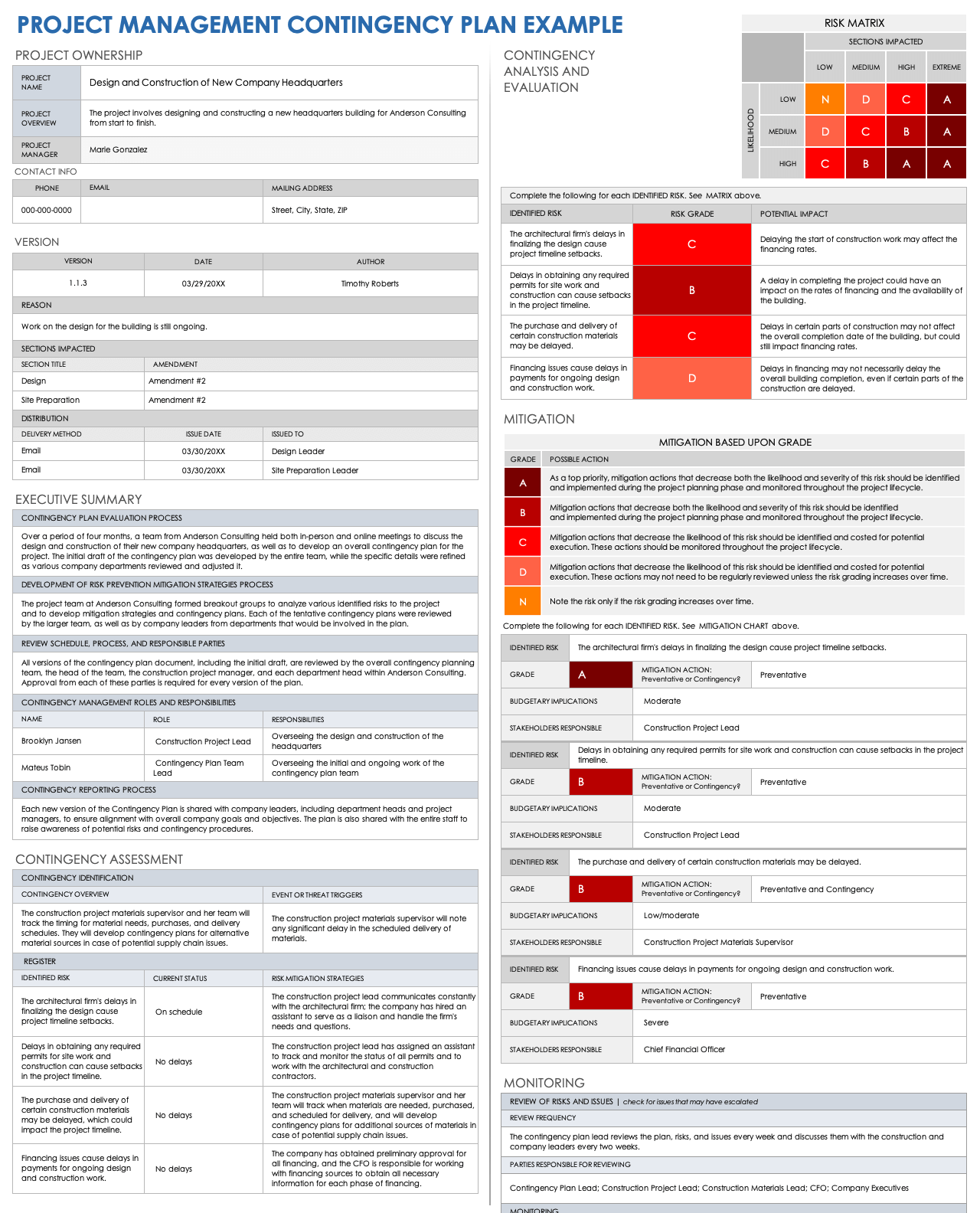What Is Contingency Planning in Project Management?
Contingency planning is what your project team does to prepare for specific risks that might happen during a project. A contingency plan might include extra funds, extra staff, or steps to take if a particular issue arises.
Contingency planning is “surviving disruptions,” says Erika Andresen, a business continuity and resilience expert, author, and Founder of EaaS Consulting. “It’s determining the priorities and making strategic decisions about how and when and where you're going to spend money and time in order to prepare for those things.”
“I consider it to be the ‘what if?’” says Melody Smith, a human resources and information systems consultant and CEO and Principal Consultant with New Jersey-based CAM Consulting Solutions. “I am the ‘what if?’ person. It drives people crazy. What if this happens? It may not; let's hope it doesn't. But it is being prepared to know that something is always going to happen, and because something is going to happen, you want to be able to have a plan of attack on how to address it, as far as making sure you have enough resources.”
What Is Project Contingency?
Project experts usually refer to project contingency as the resources set aside as part of contingency planning. These are extra financial or staff resources or extra project time that your team might need to use if a risk happens.
One form of project contingency is cost contingency. These are extra funds allotted to the project for the team to spend if certain risks happen. Another more common form of project contingency is contingency time. This is extra time built into a project schedule to account for project risks.
Experts say that project contingency, both contingency time and cost contingency, is needed in all but the smallest projects.
What Is Contingency Time in Project Management?
Contingency time is extra time that project leaders build into the overall schedule of a project. The project team can use this extra time to deal with the impacts of certain risks and avoid missed deadlines or contract penalties.
Experts sometimes use other terms that mean the same thing as contingency time, such as schedule contingency, time contingency, schedule buffer, schedule margin, and schedule float.
“Very rarely do most projects deliver on time,” says Diane Davidson, Owner of Clever Fox Advisory, a strategic planning consultancy focused on improving finance operations. “Now, I'm not talking years late, but there’s typically at least a week or two-week delay. Something always comes up. Somebody who's very important goes on vacation.”
Davidson says she builds in contingency time on almost all projects. “If we finish early, before using all contingency time, great! We save money on the project,” she says. “But if we don't finish early, then you don't have to worry about me coming back to you to say, ‘Hey, I need more money to finish this project.’ The project will still finish on budget.”
Dos and Don’ts for Establishing Contingency Time in a Project Schedule
Experts recommend a number of best practices for establishing contingency time in a project schedule. Many of these practices focus on ensuring that contingency time is visible in the project schedule. This helps the team use contingency time appropriately.
Here is the correct way to establish contingency time:
- Conduct Risk Analysis: Your team should establish contingency time based on a detailed and formal analysis of risks and how they might impact the schedule.
- Make Contingency Time Visible in the Project Schedule: Contingency time must be visible in the project schedule. You can add it to specific project phases or to the overall project. Either way, set aside a specific amount of time, usually in days or weeks, and label it as contingency time.
Experts also warn of common pitfalls with contingency time. Here are some practices to avoid when adding contingency time to your project schedule:
- Hiding Contingency Time: Team members should always clearly label contingency time in the project schedule. Never lengthen certain phases of a project — or an entire project schedule — without identifying what parts of that schedule the team considers to be contingency time. In other words, contingency time should not be hidden.
- Confusing Contingency Time with Management Reserve: Contingency time is not the same as management reserve. Some organizations use the term management reserve to define extra time and resources that management might decide that a project or an organization needs in general. Company leaders hold these resources in reserve to account for risks that are difficult to quantify or that relate to other larger organizational issues. This is different from contingency time within a project.
| Contingency Reserve | Management Reserve |
| Allocated to help project team respond to potential risks that have been identified, or “known unknowns” | Allocated for risks that cannot be quantified or foreseen, or “unknown unknowns” |
| Part of overall project budget | Not part of project budget |
| A specific amount of reserves estimated by the project team | Not estimated at a specific level but based on organizational standards |
| Fully authorized and allocated by the project manager | Not authorized or allocated by the project manager without additional approval |
How Much Contingency Should a Project Have?
Experts sometimes recommend adding a rough estimate of contingency to projects. Most often this is contingency time. When estimating the amount in this way, experts most often recommend adding 20 percent of extra time to a project for contingency.
For example, if a project is expected to take 200 hours, the team would add an additional 40 hours for contingency time.
Davidson says project leaders must be careful not to add too little contingency time — or contingency costs — to a project.
“I've seen where people have a 12-month project, and they’ll say: ‘We’ll build in an extra week,’” says Davidson. “Well, that’s not even a day per month. Or ‘This is a $6 million project — let's put in another $20,000. That’s two days of work for the number of people.
“Twenty percent [of added contingency] is what I've typically found,” she says.
Precise Ways to Figure Out Appropriate Contingency for a Project
For many projects, experts do not recommend using a broad contingency estimate. Instead, project leaders should estimate contingency with more precise tools. Some options include team estimates, Monte Carlo simulations, and phase contingency estimates.
Here are some more precise ways to estimate contingency time:
- Team Estimates: Project leaders can ask the project team to provide three estimates of the time they think they will need to finish a project or each stage of a project. The three estimates include the time needed if everything goes perfectly, the time needed if there are several problems and issues, and the most likely time. The project leaders can then establish a good estimate of contingency needed based on all of those estimates.
- Monte Carlo Simulations: Monte Carlo simulations are complex models that predict the probability of different outcomes based on a large number of variables. Project managers use these simulations to determine the most likely length and cost of a project.
Monte Carlo simulations are highly complex, which is why they are often performed with software. Financial experts also use Monte Carlo simulations to determine the most likely possibility of how an investment might perform over time. - Phase Contingency Estimates: Many experts recommend that project teams make detailed estimates of contingency amounts for each major phase of a project. These estimates are based on the risks that could happen during each specific phase. The team might also establish contingency for each subphase of a project. For instance, it might establish a contingency amount for the time it will take to get permits for a construction project.
“I think the most important elements of a contingency plan are to determine the project phases and pad the hours during the more complex stages of the program,” Davidson says. For a software development project, she continues, “This is typical during the development and testing phases. The planning and closing phases usually do not involve as much overhead and can be shortened as needed.”
Expert Tip: Always remember to label contingency amounts as contingency time within each phase, experts say. The phase shouldn’t just be lengthened from 10 weeks to 12 weeks without indicating where contingency time has been added.
When to Use a Project Management Contingency Plan
Experts recommend creating a contingency plan for any risk that could have a significant impact on a project or organization. After your team identifies project risks and conducts a thorough risk analysis, it should begin creating a contingency plan.
It’s important to understand that contingency plans can be created only for risks that your team identifies. A contingency plan cannot be created for risks that your team has not identified or would have no ability to identify or foresee.
Contingency Plan vs. Risk Management
Project risk management is the practice of identifying, managing, and mitigating risks in projects. A contingency plan is one part of project risk management. Other parts of project risk management include creating a risk log and assigning owners to risks.
To learn more about project risk management, see this comprehensive guide on risk management planning.
Contingency Plan vs. Mitigation Plan
Mitigation plans and contingency plans are similar but not identical. A mitigation plan helps you reduce the likelihood or impact of a risk, while a contingency plan helps you map the response to a risk once it occurs.
In general, a contingency plan focuses on quickly and appropriately dealing with a risk after it happens, while a mitigation plan focuses on preventative measures that make a risk less impactful or less likely to occur.
| Mitigation Plan | Contingency Plan |
| Objective is to prevent or lessen risk before it happens | Objective is to appropriately deal with risk after it happens |
| Examples of Mitigation Plan Action | Examples of Contingency Plan Action |
| Your organization consults flood maps as it decides on a site for a warehouse. It then builds the warehouse outside the floodplain or raises the ground floor of the warehouse above the level for a 100-year flood. | As a flood threatens the area where your organization built warehouses, your organization places sandbags around all existing facilities and ensures that valuable materials and items are removed from the ground floors. |
| Your organization employs cybersecurity consultants to protect your organization’s IT systems against outside attacks. You use software and other technology to monitor for and detect possible attacks. | After an external entity succeeds in attacking your IT systems, your organization immediately starts its process to deal with the attack. It informs top IT experts within your organization, brings in external help, and shuts down parts of the system. |
| Your organization is planning an outdoor event for donors and top clients. Important parts of the event will be negatively affected if it rains. You plan the event for a month when rain is less likely in your region. You also arrange for and reserve large tents and protective shelters that can be quickly constructed on-site if it rains. | You arrange for an employee to monitor the weather and make a decision on when and whether the tents need to be constructed. You hire pre-arranged workers to construct the tents on the day of the event after rain has been forecast. |
Elements of a Project Management Contingency Plan
A contingency plan should have several basic elements to help your team respond to risks when they happen. Those elements include a risk probability assessment, details on triggers for an event, and an overall response strategy.
Other important elements include a timeline for the contingency plan and a plan for communicating with important organizational leaders and project team members about the specific risk and contingency plan.
Learn more about the important elements of a contingency plan in this helpful guide to contingency planning.
How to Prepare a Project Management Contingency Plan, Step by Step
Experts recommend that your project team follow a number of basic steps to create a good contingency plan. First, identify and prioritize risks. Next, create and share your contingency plan. Finally, continually monitor and review your plan.
Here are the main steps of preparing a project management contingency plan:
- Identify the Risks: Your team will need to identify all risks that might impact your project.
- Prioritize Risks: Your team will assess all the risks that it has identified. Determine which risks are most likely to happen or could have the largest impact on the project, and use these findings to organize risks from highest to lowest priority. .
- Create a Plan: Your team will create a detailed contingency plan to deal with any risks that your team identifies as important. The plan should include how your team will address the risk when it happens. It will also assign responsibilities for tasks as part of the plan.
- Share the Plan: Once a tentative plan has been created, your team will share it with external stakeholders and team members. Review their input or suggestions as you improve the plan.
- Continually Monitor and Review the Plan: Though your plan might be finalized and approved at the beginning of the project, it could still change. As a project progresses, new risks will arise, and risk priorities will shift. Your team should continually review the contingency plan and make changes where needed.
Project Management Contingency Plan Template Example
Download a Blank Project Management Contingency Plan Template for
Excel
| Google Sheets
Download a Project Management Contingency Plan Example for
Excel
| Google Sheets
Download this completed example project management contingency plan to help you understand contingency plans. You can use this example plan template — with sections on contingency assessment, contingency analysis and evaluation, and mitigation measures — to write a contingency plan for risks in your own project.
Why Are Contingency Plans Important in Project Management?
Contingency plans are vital for managing any project that involves risk. When project managers create contingency plans, they prevent negative risks from derailing or significantly hampering the progress of a project.
Here are a few of the basic reasons contingency plans are an important part of project management:
- They Show Your Team’s Complete Preparation: Contingency plans show stakeholders and project team members that your team is fully prepared to deal with important risks.
“I think there’s no project, no activity, nothing that goes as we plan,” Davidson says. “I think we have to understand that it's very nearsighted to take a project, no matter what the duration is, and say, ‘Oh, everything is going to be a sunny day scenario.’ It’s not showing that I'm a really good project manager. A great project manager knows things are going to go off the rails. With people, maybe there’s a learning curve. Maybe people aren't picking things up as quickly — which is fine — so I build time in to assist with that. That's just showing that I understand how to run a project.” - They Lower the Risk of a Project Derailing: When risks occur, they can endanger the progress or success of a project. Contingency plans help your team ensure that won’t happen to your project, even when risks occur.
“If you have this contingency plan and are able to start to see that things are maybe starting to unravel a bit, the Debbie Downer comes out and you're able to say, ‘We may want to have someone available over the holiday because something may not work,’” says Smith. “You're more forward-thinking. You're saving time, you're saving money, and you're saving resources.”
Challenges of Contingency Planning in Project Management
Although contingency planning has many benefits, some project teams will face challenges when creating and using contingency plans. Challenges include getting buy-in from organizational leaders, being overconfident in an initial plan, and following through on contingency plans.
Here are some common challenges project managers might face during contingency planning:
- Teams View Contingency Planning as Low Priority: Some people in organizations view contingency planning as a low priority in comparison with other project management work. Project leaders often need to convince them of the importance of contingency planning.
“The line I like to use — that I took from somebody else — is, ‘Planning is hard. Explaining why you didn’t is even harder,’” says Andresen. “Because, yes, it's a pain in the butt to do the plan.” But worse, she says, is when a risk becomes a real issue and an important stakeholder asks: “You didn’t even think about this? You kind of knew this was going to happen, or that this was even potentially going to happen, and you decided not to do anything about it?” - Organizational Leaders Don’t Prioritize Contingency Planning: Even organizational leaders sometimes don’t understand the importance of contingency planning. Project leaders must work to get buy-in from company leaders and sometimes convince them of the need for contingency budgets.
“That's always been my challenge,” Smith says. “How do you influence somebody — the people who have the money, the CEOs, or even the head of departments — that we need this? All they're telling you is, ‘You have to make it work.’ I think that's the piece that's always driven me crazy.” - The Team Is Overconfident in Plan A: When your project team is very confident in your overall project plan, they may believe that there’s no need to prepare for certain risks. That can make it difficult for them to work on and support good contingency planning.
- The Team Spends Too Little Time Identifying Important Risks: Contingency planning doesn’t work when your team doesn’t identify real risks to worry about, of course. Your team must fully examine all possible risks, decide which are most important, and make plans to deal with them.
- The Team Is Uncertain About What Resources Are Available: Teams might have challenges in understanding how to plan for potential risks and issues if they don’t understand the resources available to help deal with those issues.
In those cases, the team might not “really know what to put into a contingency plan,” says Smith, “because you don't know what will be available, You can think of any piece of a project that can possibly go wrong, but if you don't know what other resources you're going to have available, it's a little difficult to be able to put that together.” - The Team Has a Plan but Doesn’t Follow It: Some organizations create a contingency plan, and when a risk becomes a reality, they frantically react and ignore the plan.
It happens more often than people might think, Andresen says: “If you have a plan, follow it. Don't make the decision not to follow the plan.”
How to Manage a Contingency Budget in Project Management
It’s important to manage a contingency budget well in project management to ensure the project team has all resources it needs to complete a project successfully. Managing a contingency budget means understanding contingency reserves, contingency costs, and contingency funds.
For more resources and information, see this guide to managing a contingency budget.
Contingency Reserve in Project Management
A contingency reserve is the amount of resources that an organization sets aside to deal with project risks. Most often, project managers allocate funds in a contingency reserve, but some managers may also include staff time.
Organizations will often use estimates and detailed calculations to determine the amount of contingency reserve they need for a project, either in costs, time, or both.
A common method for determining the amount of contingency reserve is to calculate expected monetary value (EMV) with a quantitative risk matrix. This calculation takes the probability of a risk happening and multiplies that by the estimated financial cost of the risk happening. The calculations for each risk are added together for the total contingency reserve that would be required.
EMV = Probability x Impact
Tip: Despite the name, expected monetary value can estimate contingency time as well as contingency cost.
The below graphic shows how a team might track its contingency reserve for a project, month by month. It would track the contingency reserve in concert with the project’s total budget and the running costs for the project.
Contingency Cost in Project Management
Contingency cost in project management is a part of the project budget that is allocated to risk events that are not in the original cost estimate for the project. This money can help reduce the impact of known risks and compensate for unknown risks.
A Contingency Fund in Project Management
In project management, a contingency fund is the amount reserved to cover contingency costs. Also called the contingency reserve, this fund addresses contingency costs, rather than contingency time.
Building Contingency Planning into Project Teams
Project leaders should keep in mind the importance of good contingency planning as they build their project teams. For example, having a team with diverse skill sets and a mix of experience levels will help create a balanced response to risk events.
Here are a few things project managers should keep in mind when building contingency planning into project teams:
- Create a Team with Diverse Skill Sets: Project managers should consider all skills they will need for a project, including special skills that might factor into various contingency plans for the project. They’ll want to make sure they have the range of skills required for their contingency plans.
- Assemble a Team with a Mix of Experience Levels: Project managers should consider gathering both junior and senior team members for their projects. This will give them the breadth they need to deal with various risks and issues.
- Consider Team Skill Sets: Project managers will want to understand and track the exact skills of each of their team members. This will allow them to incorporate those skills into contingency plans. It will also allow them to call on the right person immediately when a risk occurs.
The Importance of Scheduling in Project Contingency Planning
Good contingency planning can happen only when project leaders are transparent and clear about project scheduling. This means clarity on time goals for various phases of the project and what contingency time might be available.
Project managers should also continually monitor the schedule, make changes when necessary, and be transparent with the entire team about those changes.
It’s especially important for project leaders to be transparent about schedule issues and changes with organizational leaders and other important stakeholders.
As a consultant in project management, Davidson says it’s important to have conversations with clients early and often about project scope, budget, and deadlines. “It's better also to prepare because the worst thing you can do is get to the fifth month and say, ‘We're not going to deliver on time,’” she says. “I see more people get in trouble because they don't have the upfront honest conversations in the beginning. They overpromise and underdeliver.”
Effectively Plan for Contingencies with Your Projects with Smartsheet
From simple task management and project planning to complex resource and portfolio management, Smartsheet helps you improve collaboration and increase work velocity -- empowering you to get more done. The Smartsheet platform makes it easy to plan, capture, manage, and report on work from anywhere, helping your team be more effective and get more done. Report on key metrics and get real-time visibility into work as it happens with roll-up reports, dashboards, and automated workflows built to keep your team connected and informed. When teams have clarity into the work getting done, there’s no telling how much more they can accomplish in the same amount of time. Try Smartsheet for free, today.



